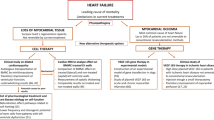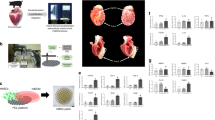Abstract
Increasing experimental evidence indicates that skeletal myoblasts can be considered as a possible source of cells for regeneration of contractile performance in chronic postinfarction myocardial injury. In experimental models, the observed functional benefit of transplanting skeletal myoblasts into an area of chronic fibrotic myocardial scar has led to the development of clinical trials to evaluate the potential use of autologous skeletal myoblasts for myocardial regeneration in patients with postinfarction heart failure. We conducted an independent, phase I clinical trial to evaluate myoblast transplantation during coronary artery bypass grafting. In addition, to test whether the effect of transplanted cells on myocardial contractility was independent of revascularization, we performed a clinical study of percutaneous transvenous myoblast transplantation—the POZNAN trial. These trials have shown the feasibility of myoblast transplantation during cardiac surgery and via a percutaneous route, as well as the safety of both procedures when performed with concurrent prophylactic administration of amiodarone. Here, we review the details of our observations from both of these phase I clinical trials in the context of the clinical work in cardiovascular cell transplantation performed by others.
This is a preview of subscription content, access via your institution
Access options
Subscribe to this journal
Receive 12 print issues and online access
$209.00 per year
only $17.42 per issue
Buy this article
- Purchase on Springer Link
- Instant access to full article PDF
Prices may be subject to local taxes which are calculated during checkout

Similar content being viewed by others

References
Siminiak T and Kurpisz M (2003) Myocardial replacement therapy. Circulation 108: 1167–1171
El Oakley RM et al. (2001) Myocyte transplantation for myocardial repair: a few good cells can mend a broken heart. Ann Thorac Surg 71: 1724–1733
Taylor DA et al. (1998) Regenerating functional myocardium: improved performance after skeletal myoblast transplantation. Nat Med 4: 929–933
Scorsin M et al. (2000) Comparison of the effects of fetal cardiomyocyte and skeletal myoblast transplantation on postinfarction left ventricular function. J Thorac Cardiovasc Surg 119: 1169–1175
Siminiak T et al. (2002) Myoblast transplantation in the treatment of postinfarction myocardial contractility impairment. Kardiol Pol 56: 131–137
Siminiak T et al. (2004) Autologous skeletal myoblast transplantation for the treatment of postinfarction myocardial injury: phase I clinical study with 12 months of follow-up. Am Heart J 148: 531–537
Siminiak T et al. (2003) Percutaneous autologous myoblast transplantation in the treatment of postinfarction myocardial contractility impairment – report on two cases. Kardiol Pol 59: 492–496
Siminiak T et al. (2005) Percutaneous trans-coronary-venous transplantation of autologous skeletal myoblasts in the treatment of post-infarction myocardial contractility impairment. The POZNAN trial. Eur Heart J 26: 1188–1195
Klug MG et al. (1996) Genetically selected cardiomyocytes from differentiating embryonic stem cells form stable intracardiac grafts. J Clin Invest 98: 216–224
Tomita S et al. (1999) Autologous transplantation of bone marrow cells improves damaged heart function. Circulation 100 (Suppl 19): II-247–II-256
Li RK et al. (1996) In vivo survival and function of transplanted rat cardiomyocytes. Circ Res 78: 283–288
Menasché P et al. (2001) Myoblast transplantation for heart failure. Lancet 357: 279–280
American Society of Echocardiography Committee on Standards, Subcommittee on Quantitation of Two-Dimensional Echocardiograms (1989) Recommendations for quantitation of the left ventricle by two-dimensional echocardiography. Am Soc Echocardiogr 2: 358–367
Rozwadowska N et al. (2002) Evaluation of in vitro culture of human myoblasts for tissue autotransplants to the post-infarction heart. Kardiol Pol 57: 233–241
Criteria Committee of the New York Heart Association (1994) Nomenclature and Criteria for Diagnosis of Diseases of the Heart and Great Vessels, 9th Edn, 253–256. Boston: Little, Brown
Smits PC et al. (2003) Catheter-based intramyocardial injection of autologous skeletal myoblasts as a primary treatment of ischemic heart failure. Clinical experience with six-month follow-up. J Am Coll Cardiol 42: 2063–2069
Reinecke H et al. (2000) Electromechanical coupling between skeletal and cardiac muscle. Implications for infarct repair. J Cell Biol 149: 731–740
Menasché P et al. (2003) Autologous skeletal myoblast transplantation for severe postinfarction left ventricular dysfunction. J Am Coll Cadiol 41: 1078–1083
Dib N et al. (2003) Two year follow up of the safety and feasibility of autologous myoblast transplantation in patients with ischemic cardiomyopathy: results from the United States experience [abstract]. Circulation 108 (Suppl IV): IV-623
Herreros J et al. (2003) Autologous intramyocardial injection of cultured skeletal muscle-derived stem cells in patients with non-acute myocardial infarction. Eur Heart J 24: 2012–2020
Chachques JC et al. (2003) Autologous human serum for cell culture avoids the implantation of cardioverter-defibrillators in cellular cardiomyoplasty [abstract]. Circulation 108 (Suppl IV): IV-623
Pagani FD et al. (2003) Autologous skeletal myoblasts transplanted to ischemia-damaged myocardium in humans. Histological analysis of cell survival and differentiation. J Am Coll Cardiol 41: 879–888
Haider HK et al. (2004) Myoblast transplantation for cardiac repair: a clinical perspective. Mol Ther 9: 14–23
Ince H et al. (2004) Transcatheter transplantation of autologous skeletal myoblasts in postinfarction patients with severe left ventricular dysfunction. J Endovasc Ther 11: 695–704
Acknowledgements
The research was supported by a governmental grant from Komitet Badan Naukowych (State Committee for Scientific Research) and by an unrestricted research grant from the Polpharma Foundation.
Author information
Authors and Affiliations
Corresponding author
Ethics declarations
Competing interests
The authors declare no competing financial interests.
Rights and permissions
About this article
Cite this article
Siminiak, T., Burchardt, P. & Kurpisz, M. Postinfarction heart failure: surgical and trans-coronary-venous transplantation of autologous myoblasts. Nat Rev Cardiol 3 (Suppl 1), S46–S51 (2006). https://doi.org/10.1038/ncpcardio0403
Received:
Accepted:
Issue Date:
DOI: https://doi.org/10.1038/ncpcardio0403
This article is cited by
-
Extending Flaps Lifts an Infarcted Heart Toward Repair
Molecular Therapy (2015)
-
Engineering Angiogenesis for Myocardial Infarction Repair: Recent Developments, Challenges, and Future Directions
Cardiovascular Engineering and Technology (2014)
-
Catheter-based delivery of cells to the heart
Nature Clinical Practice Cardiovascular Medicine (2006)


